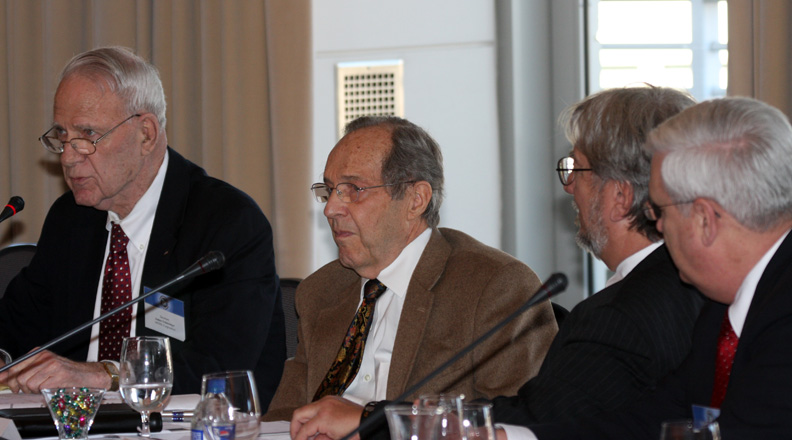CONTACTS
 |

SW21 2009
Forces, Infrastructure, and Science & Technology:
Options for Hedging
William Perry
For additional perspective, see the Interim Report of the Congressional Commission on the Strategic Posture of the United States (pdf) and the Op Ed piece, “Toward a Nuclear Free World,” appearing in the Wall Street Journal on January 15, 2008.

(L-R) James Schlesinger, Secretary of Defense; William Perry, Secretary of Defense; Michael Anastasio, Director LANL; George Miller, Director LLNL
We have been drifting towards nuclear catastrophe, one that would not be as bad as general nuclear exchange, but very bad. There are social, political, economic and other trends pointing in this direction. A number of nuclear fuel cycle issues are looming. The threat is increasing, and we are at a tipping point. It is very possible that a proliferation cascade will follow actions by Iran and the DPRK. Our actions have consequence, but usually not for rogue states. Rather the consequences are seen in the behavior of other potential proliferators. We are drifting towards a new sort of cold war, and must avoid an action-reaction cycle that could make things worse.
We must maintain a safe, secure, reliable and sufficient nuclear deterrent for the foreseeable future, but we must do it right. We must maximize our ability to curb proliferation and contain the potential for ‘cold war' while maintaining deterrence. We must stop going down the ‘mountain of zero' and start going up. We must establish a base camp.
The Congressional Commission is a work in progress. It notes that the primary danger now is nuclear terrorism, and we must increase the emphasis on curbing proliferation. Russia remains an existential threat. It is rebuilding, and there is harsher political rhetoric. We should restart a strategic dialog on curbing proliferation and building cooperation on arms reductions.
The U.S. should continue to reduce its reliance on nuclear weapons, and do so transparently. We should support existential deterrence, and continue our ambiguity regarding first use. We can make further reductions, some bilaterally and some unilaterally. There is no consensus in the Commission yet on force structure. There is no consensus yet on the CTBT, though Perry believes ratification would be good. A safe and secure stockpile depends on ‘safe and secure' funding, as well as on people and leadership. This relationship is fragile and endangered as people lose interest. LEPs are not necessarily the long-term solution, and new designs or some sort of hybrid may prove preferable. In any case, we must retain a capacity for pursuing and producing new designs. Infrastructure will be addressed in the final report, which is due in April. It may not achieve consensus on all issues.
James Schlesinger
We will need a nuclear deterrent for the indefinite future. In some ways, we need our deterrent less for ourselves than to maintain our nuclear umbrella (assurance) over more than 30 other countries – and more are seeking to come under that umbrella. In reality, Russia is less of a threat to us than to those we protect. Our posture keeps some of them from ‘rolling their own.' DPRK and Iran threaten to push us past the proliferation tipping point, but we have little influence over them.
Our force size now depends on Russia, which has is implementing a doctrine of more reliance on non-strategic nuclear weapons. For now, the PRC is not the same sort of threat. NATO expansion complicates our life, not least for the question of whether to extend deterrence to the former Warsaw Pact. In any case we need a renewed strategic dialog with Russia. (Note its recent threats of nuclear use against Warsaw and Prague.) Unilateral reductions would be unwise. Numbers are not the issue; stability is.
John Day
Hedging has long been central to the strategic posture of the UK, providing risk management in an uncertain world. Our antinuclear lobby is a small but noisy one, representing some 25% of public opinion. Other factors dictated the need for a re-examination. For example, our infrastructure faced continuing decay until the 2000-2002 period when this trend was reversed. The 2006 White Paper and associated Parliamentary debate established political foundation for moving forward. Future strategic options, including a ground-based deterrent, were examined, but we are now looking to ensure Trident continuity through the 2040s. The processing of determining future direction has been underway since 2000, and provides a strong baseline for continuing choices. Perhaps the U.S. can draw some insights from our process. It should be noted that U.S. nuclear deterrent posture is fundamental to UK security.
It was remarked during discussion that the U.S. needs a comprehensive strategy encompassing nuclear posture, arms control, the role of defenses, etc. Since this cannot all be accomplished from the Pentagon, perhaps it needs to be led by the National Security Council, and include State and other appropriate agencies. It was also noted that in the UK, the government built a high level of consensus, and then refused to re-open the debate, sticking to the argument that the alternative is unacceptable. Similarly, the U.S. Commission is Congressionally mandated, and is working hard on consensus. If the new NPR is consistent then it may endure.
 |


